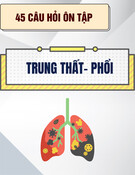
Can Tho Journal of Medicine and Pharmacy 9(5) (2023)
79
12. Tham Hoang Diep (1992), Morphological and physical characteristics of students at Hanoi
junior high school, Thesis of Doctor of Science in Medicine and Pharmacy, Hanoi Medical
University, Ha Noi.
13. Tran Viet Cuong (2003), Weight, height of junior high school students and some influencing
factors (Long An province - 2003), Master's thesis of Medicine, University of Medicine and
Pharmacy, Ho Chi Minh City.
14. Trinh Huu Vach, Le Gia Vinh (1986), “Recommending indexes and scales for classifying body
fatness and leanness of adult Vietnamese adults”, Vietnamese Medicine, Medical publisher, 2,
pp. 20-26.
15. WHO (2007), “BMI-For-Age Boys 5 to 19 years”, Growth reference 5-19 years, pp. 3-5.
16. WHO (2007), “BMI-For-Age Girls 5 to 19 years”, Growth reference 5-19 years, pp. 3-5.
17. Jing-Jing L., Zhe-Qing Z., Ya-Jun C., Jin-Cheng M., et al. (2016), "Dental caries is negatively
correlated with body mass index among 17-19 years old children in Guangzhou, China ", BMC
Public Health 16(1), pp. 2-7.
(Received: 14/07/2022 – Accepted: 25/11/2022)
RESEARCH ON DESCRIPTION OF ACUTE APPENDICITIS OF
ULTRASONOGRAPHIC CHARACTERISTICS
Nguyen Kim Ngan*, Nguyen Thi Giao Ha, Pham Nguyen Nhu Phuong,
Nguyen Thanh Tuan, Nguyen Nhan Tho, Nguyen Trong Kha
Can Tho University of Medicine and Pharmacy
Corresponding author: nkngan1410@gmail.com
ABSTRACT
Background: Acute appendicitis is one of the most common causes of lower abdominal pain leading
patients to admit the emergency department. Besides those developed paraclinical tests, ultrasound is the
priority to support the diagnosis. Objectives: To survey and update the ultrasonographic characteristics of
acute appendicitis in diagnosis at Can Tho University of Medicine and Pharmacy Hospital. Materials and
methods: A cross-sectional descriptive study of 115 acute appendicitis patients diagnosed at Can Tho
University of Medicine and Pharmacy Hospital from December 2021 to July 2022, using SPSS 20 software
to analyze data. Results: Among 115 patients that were diagnosed with acute appendicitis by ultrasound,
the right iliac fossa was the most frequent location of the appendix (98.3%) and 1.7% of patients with acute
appendicitis located behind the cecum. The direction signs suggested acute appendicitis on ultrasound were
described by target sign and finger sign at 100%, appendiceal diameter >= 6mm at 97.4% and the average
appendiceal length was 7cm ± 2cm. The indirection signs were fluid around the appendix (9.6%), fluid
around right iliac fossa (4.3%), fecal stones in the appendix (8.7%), fluid in the appendix (16.5%),
infiltrating around the appendix (74.8%) and lymph nodes response (7.8%). Conclusion: Our study
updates data about acute appendicitis ultrasonographic image characteristic figures as well as a reference
for clinical doctors to diagnose acute appendicitis by ultrasonography.
Keywords: acute appendicitis, direction signs, indirection signs, ultrasound.






























